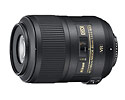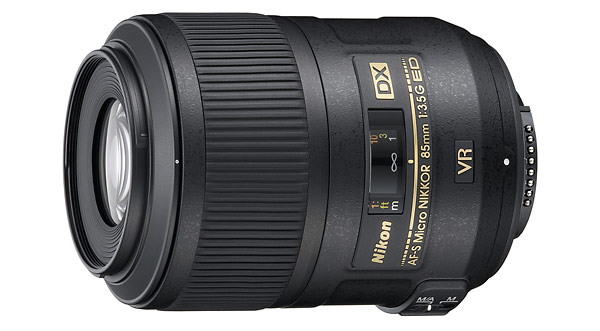 Along with the new D3S digital SLR announced on Tuesday, Nikon also introduced a new DX-format macro lens. The Nikon AF-S DX 85mm f/3.5 Micro Nikkor VR II lens is designed to be used with APS-C sensor Nikon digital SLRs like the D5000, D60, D300s and D3000. The 85mm focal length is effectively converted to 127.5mm (35mm equivalent) on a DX-format camera body. The “Micro” in the name means it’s designed for close-up photography. In this case, that means a minimum focus distance of 9 inches and a 1:1, life-size reproduction ratio.
Along with the new D3S digital SLR announced on Tuesday, Nikon also introduced a new DX-format macro lens. The Nikon AF-S DX 85mm f/3.5 Micro Nikkor VR II lens is designed to be used with APS-C sensor Nikon digital SLRs like the D5000, D60, D300s and D3000. The 85mm focal length is effectively converted to 127.5mm (35mm equivalent) on a DX-format camera body. The “Micro” in the name means it’s designed for close-up photography. In this case, that means a minimum focus distance of 9 inches and a 1:1, life-size reproduction ratio.
|
“The introduction of the AF-S DX 85mm Micro lens further broadens the Micro NIKKOR family and answers a call from serious nature and portrait photographers, generalists and on-line auction specialists seeking superior close-up shooting performance, affordability and versatility.”
Edward Fasano, Nikon SLR Systems Marketing General Manager |
Most of my shooting is down outdoors, on the trail, where smaller, lighter camera gear is better. I made the commitment to smaller, APS-C (that’s the DX-format for Nikon DSLRs) digital SLRs a few years ago because they’re easier to pack on the mountain bike and skis. The new DX-format 85mm Micro Nikkor lens might not look like much at first glance. It’s not a zoom, the maximum aperture isn’t very fast and it’s not an FX-format full frame lens. But take a closer look and this lens gets more interesting. I pulled up the specs on the 85mm Micro DX lens and compared the size and weight to other Nikkor macro lenses. Yeah, the AF-S 105mm f/2.8G VR Micro Nikkor and AF-S 60mm f/2.8G Micro Nikkor both have a faster, f/2.8 aperture. But at 27.9 oz. (790g) and 15 oz. (425g), respectively, they both weigh more than the 12.5 oz. (355g), 85mm Micro Nikkor. The 105mm Micro Nikkor weighs more than twice as much and both of the non-DX lenses take larger, more expensive 62mm filters. That’s gonna cost you a pretty penny if you want a circular polarizer. There’s about a $20 difference in price between 52mm and 62mm circular polarizing filters* if you want a good one.

You can never judge camera gear on specs alone. Only real-world testing tells the whole story. But on paper, the new Nikon AF-S DX 85mm f/3.5 Micro Nikkor lens looks pretty good – especially if you’re an outdoor photographer or someone else who wants a compact, light lens for close-up photography or portraits. An ED (Extra-low Dispersion) optical element reduces chromatic aberration (color “fringing”) and an aperture with nine rounded blades means better bokeh. For those who don’t know what “bokeh” means – more, rounded blades in the aperture make the out-of-focus foreground and background in a photo look softer and more natural. The VR (Vibration Reduction) optical image stabilization makes shooting without a tripod easier. Nikon claims up to four stops of shutter speed compensation from the VR system in this lens. That means more useable photos in lower light and sharper close-ups without a tripod. Backcountry wildflower photographers will find the VR especially useful as it will make flower close-ups without a tripod a lot easier. Packing your tripod is still the right thing to do. But if you get lazy or forget it, you’ll still be able to get handheld close-ups with the Nikon AF-S DX 85mm f/3.5 Micro Nikkor VR lens.
The new Nikon AF-S DX 85mm f/3.5 Micro Nikkor VR II lens should start showing up at camera shops and online retail sites in early December. The expected retail price is $529.95.
Nikon AF-S DX 85mm Micro Nikkor VR II Lens Press Release >>
*Comparison was for the 52mm and 62mm Hoya HMC multi-coated circular polarizer filters on the B&H Photo Web site.
Related Content:
Nikon Review Page
All Lens User Reviews
Nikon Cameras Forum
Digital SLR Forum
More Nikon News And Articles
Nikon Web Site


This is a great lens I do nature photography and this lense is one of the ACEs on my arcenal, It is crisp sharp as a tac and has great focusing speed, great for the semi-pro photographer.